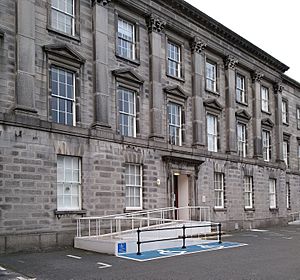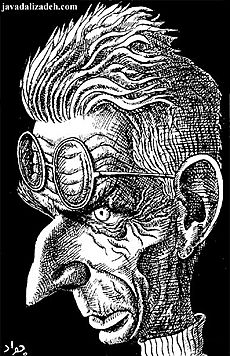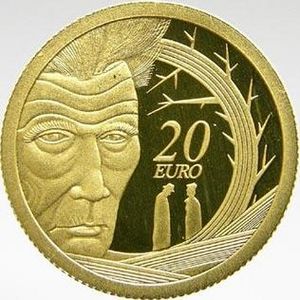Samuel Beckett facts for kids
Quick facts for kids
Samuel Beckett
|
|
|---|---|

Beckett in 1977
|
|
| Born | Samuel Barclay Beckett 13 April 1906 Foxrock, Dublin, Ireland |
| Died | 22 December 1989 (aged 83) Paris, France |
| Occupation |
|
| Language |
|
| Education |
|
| Notable works |
|
| Notable awards |
|
| Spouse |
Suzanne Dechevaux-Dumesnil
(m. 1961; died 1989) |
| Signature | |
Samuel Barclay Beckett (born 13 April 1906 – died 22 December 1989) was an Irish writer. He wrote novels, plays, short stories, and poems. He also directed plays and translated books. Beckett spent most of his adult life living in Paris, France. He wrote in both English and French.
His writing often explored the difficult and sometimes funny parts of life. His plays and books became simpler over time. He is known for using repetition and self-reference in his work. Beckett is seen as one of the last important writers of the Modernist period. He was also a key figure in what is called the Theatre of the Absurd. This type of theatre shows how life can seem meaningless.
During World War II, Beckett was part of the French Resistance. This was a group that fought against the German occupation. For his brave actions, he received the Croix de Guerre in 1949. In 1969, he won the Nobel Prize in Literature. This award recognized how his writing showed the struggles of modern people in new ways.
Contents
His Early Life and Education
Samuel Barclay Beckett was born in Foxrock, a suburb of Dublin, Ireland. His birthday was 13 April 1906. His father, William Frank Beckett, was a surveyor. His mother, Maria Jones Roe, was a nurse. Samuel had one older brother, Frank Edward.
When he was five, Samuel went to a local playschool in Dublin. He started learning music there. Later, he attended Earlsfort House School. His family belonged to the Church of Ireland. Beckett was raised as an Anglican, but later became agnostic. This way of thinking influenced his writing.
The Beckett family home was called Cooldrinagh. It was a large house with a garden and a tennis court. This house and the areas around it, like the Leopardstown Racecourse, appeared in his stories and plays.
Around 1919, he went to Portora Royal School in Enniskillen. Famous writer Oscar Wilde also went to this school. Samuel left in 1923 and went to Trinity College Dublin. There, he studied modern literature and languages like French and Italian. He earned his bachelor's degree in 1927.
Beckett was also a good athlete. He was excellent at cricket. He played for Dublin University Cricket Club. He even played in two professional-level games. This made him the only Nobel literature winner to have played first-class cricket.
Becoming a Writer
After college, Beckett taught English for a short time in Belfast. Then, from 1928 to 1930, he taught in Paris, France. While there, he met the famous Irish author James Joyce. This meeting had a big impact on Beckett. He even helped Joyce with research for his book Finnegans Wake.
In 1929, Beckett published his first work. It was an essay defending Joyce's writing style. His first short story, "Assumption," was also published around this time. The next year, he won a small prize for his poem "Whoroscope."
In 1930, Beckett returned to Trinity College as a lecturer. He gave a funny speech in French about a made-up poet. He later said he did not mean to trick his audience. Beckett left his teaching job at the end of 1931. His short career in academics was over.
Beckett traveled a lot in Europe. In London, he published a book about the French author Marcel Proust in 1931. After his father died in 1933, Beckett started two years of therapy. Some of these experiences showed up in his later works, like Watt and Waiting for Godot.
In 1932, he wrote his first novel, Dream of Fair to Middling Women. Publishers did not want it, so he gave up on it. However, this novel gave him ideas for his early poems. It also helped him write his first full book of short stories, More Pricks Than Kicks, published in 1933.
In 1935, Beckett published a book of his poems called Echo's Bones and Other Precipitates. He also worked on his novel Murphy. He was interested in film and wanted to study in Moscow. He even wrote to famous directors, but nothing came of it. Murphy was finished in 1936 and published in 1938. Beckett translated it into French later.
He decided to live permanently in Paris. He stayed there even after World War II began in 1939. He said he preferred "France at war to Ireland at peace." He became friends with artists like Alberto Giacometti and Marcel Duchamp.
Life During World War II
After Nazi Germany took over France in 1940, Beckett joined the French Resistance. He worked as a courier, carrying messages. He was almost caught by the German secret police (Gestapo) several times. In August 1942, his group was betrayed. He and his partner, Suzanne, had to flee south on foot. They found safety in a small village called Roussillon.
Beckett stayed in Roussillon for two years. He helped the French Resistance fight the German army. He rarely talked about his war work later in life. The French government gave him the Croix de guerre and the Médaille de la Résistance. But Beckett always called his Resistance work "boy scout stuff."
While hiding in Roussillon, Beckett kept working on his novel Watt. He started it in 1941 and finished it in 1945. It was published in 1953. After the war, he returned to France in 1946. He worked at an Irish Red Cross Hospital.
Fame: Novels and Theatre

In 1945, Beckett visited Dublin. While there, he had an important realization. He felt he would always be in the shadow of James Joyce. He realized his own writing needed to focus on failure, loss, and how little humans truly know. This moment was very important for his career. He later wrote about it in his play Krapp's Last Tape (1958).
In 1946, a French magazine published part of his short story "Suite." Beckett also started writing his fourth novel, Mercier and Camier. This novel was published much later, in 1970. It was important because it was Beckett's first long work written in French. He continued to write most of his later works in French. He said it helped him write "without style," meaning more simply.
His French publisher strongly supported him. This included his famous "trilogy" of novels: Molloy (1951), Malone Dies (1951), and The Unnamable (1953).
Beckett is most famous for his play Waiting for Godot (1953). He wrote it in French between 1948 and 1949. His partner, Suzanne Dechevaux-Dumesnil, helped him greatly. She became his agent and sent the play to many producers. They eventually found Roger Blin, who directed the play.
A critic once famously said that Beckett "has achieved a theoretical impossibility—a play in which nothing happens, that yet keeps audiences glued to their seats." The play opened in Paris in 1953 and was a big success. An English version was performed two years later. It became very popular around the world. Beckett never sold the manuscript for this play. He also did not allow it to be made into a film, but he did allow it on television.
In the 1950s, Beckett sometimes drove local children to school. One of these children was André Roussimoff, who later became the famous wrestler André the Giant. They bonded over their love of cricket.
Beckett translated all his own works into English, except for Molloy. The success of Waiting for Godot started his career in theatre. He wrote other successful plays, including Endgame (1957), Krapp's Last Tape (1958), and Happy Days (1961). In 1961, he won the International Publishers' Formentor Prize.
Later Life and Death
The 1960s brought many changes for Beckett. In 1961, he secretly married Suzanne in England. The success of his plays led to invitations to attend rehearsals worldwide. This led to a new career as a theatre director. He also started writing for radio and television. He began writing in English again, but still wrote in French too. In 1953, he bought land and built a small house near Paris.
From the late 1950s until his death, Beckett had a relationship with Barbara Bray. She was a script editor for the BBC. This relationship continued alongside his marriage to Suzanne. Barbara Bray died in 2010.
In October 1969, while on holiday, Beckett learned he had won the 1969 Nobel Prize in Literature. Suzanne called the award a "catastrophe." She knew it would bring him unwanted fame. Beckett was a very private person. He did not give many interviews. But he sometimes met artists and admirers in a hotel lobby in Paris.
Suzanne died on 17 July 1989. Beckett was in a nursing home and had health problems. He died a few months later, on 22 December 1989. They were buried together in the Montparnasse Cemetery in Paris. Their simple gravestone is grey, just as Beckett wanted.
His Works
Beckett's writing career can be split into three main parts. His early works were before 1945. His middle period, from 1945 to the early 1960s, includes his most famous works. His late period, from the 1960s until his death, features shorter and simpler works.
Early Works
Beckett's first works were greatly influenced by his friend James Joyce. They were very scholarly and sometimes hard to understand. They showed off his knowledge.
His first published novel, Murphy (1938), explored themes of madness and chess. These ideas would appear again in his later works. The first sentence of Murphy shows his dark humor: "The sun shone, having no alternative, on the nothing new." Watt, written during World War II, was similar but simpler in style. It looked at human movement like a math problem.
Beckett's 1930 essay Proust was influenced by a philosopher who believed in pessimism. Around this time, Beckett started writing creatively in French. His French poems were very simple. This showed that he was making his style simpler, even in another language.
Middle Period
After World War II, Beckett decided to write mostly in French. This, along with his important realization in Dublin, led to his most famous works. He realized his art needed to come from his own inner world.
In the 15 years after the war, Beckett wrote four major plays: Waiting for Godot (1948–1949), Endgame (1955–1957), Krapp's Last Tape (1958), and Happy Days (1961). These plays are often linked to the "Theatre of the Absurd." They use dark humor to explore themes similar to those of thinkers who believed in existentialism.
These plays generally deal with feelings of hopelessness. But they also show the will to keep going, even in a world that seems confusing. A character in Endgame says, "Nothing is funnier than unhappiness... Yes, it's the most comical thing in the world. And we laugh, we laugh... But it's always the same thing."
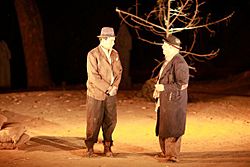
Beckett's greatest novels from this time were Molloy (1951), Malone Dies (1951), and The Unnamable (1953). These are sometimes called a "trilogy." In these books, his writing became even more simple. Molloy still has a plot and characters. But in Malone Dies, the story is mostly an inner monologue. In The Unnamable, there is almost no sense of place or time. The main idea is the struggle to keep speaking to exist, versus the desire for silence. Even though his work is often seen as sad, the will to live usually wins. The famous last line of The Unnamable is: "I can't go on, I'll go on."
After these novels, Beckett found it hard to write long prose works. In the late 1950s, he wrote How It Is (1961). This book tells the story of a narrator crawling through mud. It is written in short, unpunctuated paragraphs. This work is usually seen as the end of his middle period.
Late Works
Throughout the 1960s and 1970s, Beckett's works became even shorter and more compact. This is why his work is sometimes called minimalist. An extreme example is his 1969 play Breath, which lasts only 35 seconds and has no characters.
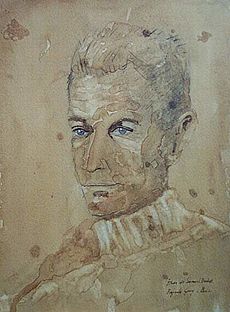
In his later plays, the number of characters became very small. Play (1962) has three characters buried up to their necks in urns. The TV play Eh Joe (1963) focuses on the main character's face. The play Not I (1972) is mostly just a moving mouth in the darkness. Many of these later plays explore memory. They also deal with the idea of being alone and watched. Beckett's most political play, Catastrophe (1982), was dedicated to Václav Havel. It talks about dictatorship.
Beckett's prose works were less common in this period. But he had a new burst of creativity with the novella Company (1980). This continued with Ill Seen Ill Said (1982) and Worstward Ho (1983). Themes of loneliness and the wish to connect with others appear in these works.
In the nursing home where he spent his last days, Beckett wrote his final work. It was a 1988 poem called "What is the Word." The poem deals with not being able to find words to express oneself. This was a theme throughout his work.
Collaborators
Beckett worked closely with several actors and designers.
Jack MacGowran
Jack MacGowran was the first actor to perform a one-man show based on Beckett's works. He performed End of Day in 1962. Beckett even directed him in Paris in 1970. Beckett wrote the radio play Embers and the TV play Eh Joe especially for MacGowran.
Billie Whitelaw
Billie Whitelaw worked with Beckett for 25 years. She acted in plays like Not I, Eh Joe, and Rockaby. She first met Beckett in 1963 and said it was "trust at first sight." Beckett wrote many of his experimental plays for her. She was seen as his inspiration and the best at performing his work. She once said, "Sam knew that I would turn myself inside out to give him what he wanted."
Jocelyn Herbert
The English stage designer Jocelyn Herbert was a close friend of Beckett. She worked with him on plays like Happy Days and Krapp's Last Tape. Beckett said she was his closest friend in England. He praised her for not overdoing the designs.
Walter Asmus
The German director Walter D. Asmus started working with Beckett in 1974. Their collaboration lasted until Beckett's death in 1989. Asmus has directed all of Beckett's plays around the world.
His Legacy
Beckett's work was a strong challenge to traditional storytelling. He showed that theatre and fiction do not need a typical plot or fixed time and place. Instead, they can focus on the basic parts of being human. Many famous writers have said they were influenced by Beckett. These include Václav Havel, Tom Stoppard, and Harold Pinter. He also influenced experimental writing and art since the 1950s.
Many composers have created music based on Beckett's texts. His work has also influenced international writers, artists, and filmmakers.
Beckett is one of the most talked-about writers of the 20th century. Some early thinkers praised him for showing the absurdity of life. Others criticized him for not being realistic enough.
After Beckett's death, his family manages the rights to his plays. They are very strict about how his plays are performed. They want productions to follow his original stage directions exactly.
The Irish postal service issued a stamp of Beckett in 1994. In 2006, the Central Bank of Ireland released two special coins to celebrate 100 years since his birth.
On 10 December 2009, a new bridge in Dublin was named the Samuel Beckett Bridge in his honor. It looks like a harp on its side. An Irish Naval Service ship, the LÉ Samuel Beckett (P61), is also named after him.
There is an annual festival in Enniskillen, Northern Ireland, celebrating Beckett's work. It is called the Happy Days Enniskillen International Beckett Festival. The Samuel Beckett Award was created in 1983 for writers who show new and excellent ideas in performing arts.
Honours and Awards
- Croix de guerre (France)
- Médaille de la Résistance (France)
- 1959 honorary doctorate from Trinity College Dublin
- 1961 International Publishers' Formentor Prize (shared with Jorge Luis Borges)
- 1968 Foreign Honorary Member of the American Academy of Arts and Sciences
- 1969 Nobel Prize in Literature
- Saoi of Aosdana (Ireland)
- 2016 English Heritage Blue Plaque at his former home in London
- Obies (for Off-Broadway plays):
-
- 1958 Endgame
- 1960 Krapp's Last Tape
- 1962 Happy Days
- 1964 Play
Selected Works by Beckett
Dramatic Works
|
Theatre
|
Radio Plays
Television Plays
Cinema
|
Prose Works
|
Novels
Short Prose
|
Non-fiction
Poetry Collections
|
Images for kids
See also
 In Spanish: Samuel Beckett para niños
In Spanish: Samuel Beckett para niños


